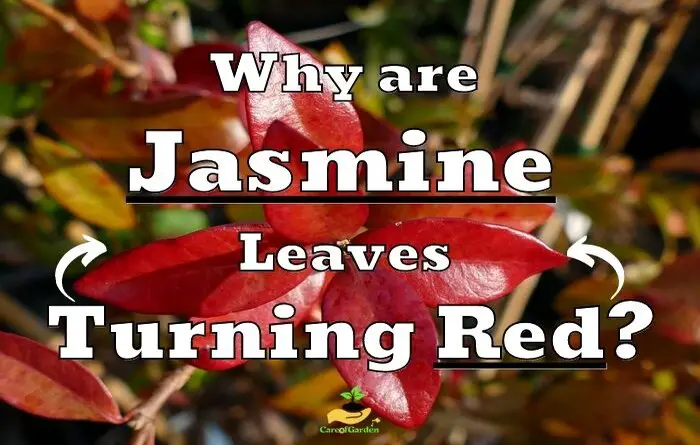Why are Jasmine Leaves Turning Red? 7 Reasons & Solutions
As a biologist specializing in ornamental plants, I am often asked why are jasmine leaves turning red. Don’t worry, it’s not uncommon and I’ve seen this happen many times, especially to beginner gardeners who are just starting to learn the ins and outs of plant care.
That’s a sign that something is wrong, and the causes are many, from pests to even environmental factors. This article will help you to identify the cause and offer solutions to this problem.
Jasmine leaves can turn red due to several reasons, including water stress, nutrient deficiency, exposure to extreme temperatures or sunlight, pests, or fungal infections like powdery mildew, anthracnose, leaf spot. Over-watering is a common reason for red leaves, so make sure to water your jasmine plants properly. Nutrient deficiencies can also cause red leaves, so add organic fertilizer to the soil.
Identifying the Cause why Jasmine Leaves are Turning Red
Jasmine is a plant loved by many due to its beautiful flowers and pleasant aroma. Identifying the cause of why your jasmine leaves are turning red is essential to correcting this problem and understanding what is going on in your garden.
Next, we will discuss the lead causes for this problem in your jasmine.
1. Sun exposure
Jasmine is a sun-loving plant, but too much exposure can harm it. When the jasmine is exposed to too much sun, the leaves can turn red and dry. The redness occurs because intense sunlight can burn the leaves and damage plant cells.
It’s a problem that happens especially during the summer or in regions with a high intensity of the sun.
Solution
Move your jasmine plant to a location with less sun and more shade. If this is impossible, you can cover the plant with a light cloth or screen to protect it from direct sunlight. Be sure to water the plant more often in hot weather to prevent the soil from drying out and the leaves from turning red.
2. Problems with watering
Jasmine needs enough water to grow and flourish. A lack or excess of water is one of the most common causes of why jasmine leaves are turning red.
If the plant is getting too little water, the leaves may wilt and turn red. It occurs because the lack of water prevents the plant from absorbing essential nutrients and minerals, resulting in a malfunction of the plant’s vascular system.
On the other hand, if the plant is getting too much water, the roots can rot, causing the leaves to turn red as well.
Solution
Water the jasmine plant frequently and carefully, avoiding overwatering, especially during the hot, dry months. Ensure the soil is always moist but not soggy to prevent root rot.
| Watering Frequency | Soil Moisture Level |
|---|---|
| Every 2-3 days | Keep soil evenly moist |
| Once a week | Allow top inch of soil to dry out |
| Every 10-14 days | Allow top half of soil to dry out |
| Every 2-3 weeks | Allow soil to dry between watering |
| Varied | Adjust based on plant’s response |
3. Pests
Another possible cause for jasmine leaves turning red is the presence of pests or diseases on the plant. Some of the most common pests that affect jasmine are aphids, mealybugs, and spider mites.
Pests and insects are common in plants, as they come by the wind or on the body of humans and animals and are difficult to control.
Solution
Regularly inspect your jasmine plants for signs of pests and insects. If you detect any problems, use a suitable pesticide to protect the plant.
4. Diseases
Jasmine can be affected by several diseases such as fungal, bacterial, and even viruses. These diseases are transmitted in several ways, mainly through insect bites.
Diseases such as mildew and root rot are known to cause a variety of problems in jasmine. When the plant is infected, its leaves may turn red, stain, or even fall off.
| Disease | Description | Treatment |
|---|---|---|
| Powdery mildew | Fungal disease that appears as a white or gray powdery coating on leaves, stems, and flowers; can cause leaves to turn red or purple in some cases | Apply fungicides or sulfur (1-2 tsp per quart of water), start to prune the affected areas. |
| Bacterial leaf spot | Bacterial disease that appears as small, water-soaked lesions on leaves that gradually turn reddish or purplish in color | Remove infected leaves, apply copper-based fungicides or streptomycin (1 tsp per quart of water). |
| Leaf blight | Fungal disease that causes dark spots or lesions on leaves that may have a reddish or purplish coloration | Remove the affected jasmine leaves or stems; treat with fungicides such as neem oil (1-2 tsp per quart of water) or copper sulfate(1-2 tsp per quart of water). |
| Leaf spot | Fungal disease that causes dark spots or lesions on leaves that may have a reddish or purplish coloration | Treat with fungicides such as neem oil (1-2 tsp per quart of water), copper sulfate (1-2 tsp per quart of water), or potassium bicarbonate (1-2 tsp per quart of water); ensure good air circulation and avoid overhead watering. |
| Anthracnose | Leaves turn red or yellow, spots may appear. | Apply fungicides such as neem oil (1-2 tsp per quart of water), copper sulfate (1-2 tsp per quart of water), or potassium bicarbonate (1-2 tsp per quart of water). |
Solution
Keep the plant clean from insects and without high humidity, thus preventing fungus and diseases from developing.
If the plant becomes infected, remove the affected leaves and branches immediately and use a fungicide or other treatment suitable for the species of jasmine you are growing.
Remember to follow product instructions and not exceed recommended servings. Regularly check your plant for pests and diseases.
5. Insufficient nutrients
Just like other plants, jasmine needs enough nutrients to grow and flourish. If the jasmine plant does not receive enough nutrients, the leaves may start to turn red.
This is because the lack of nutrients affects the plant’s ability to carry out photosynthesis. Each deficiency exhibits a different set of symptoms; the red color on the leaves is a common symptom of several deficiencies.
One nutrient deficiency that can lead to reddish or purplish leaves in jasmine plants is a phosphorus deficiency. Phosphorus is essential for plant growth and development, and when there is not enough of it available to the plant, the leaves may take on a reddish or purple hue.
| Nutrient Deficiency | Description | Possible Causes |
|---|---|---|
| Phosphorus deficiency | Causes leaves to turn reddish or purplish; essential for plant growth and development | Low phosphorus levels in soil |
| Iron deficiency | Causes leaves to turn yellow or pale green with reddish or purplish veins | Low iron levels in soil |
| Magnesium deficiency | Causes leaves to turn yellow, followed by reddish or purplish coloring | Low magnesium levels in soil |
| Nitrogen deficiency | Causes leaves to turn pale green or yellow, sometimes with reddish or purplish coloring | Low nitrogen levels in soil |
Solution
Identify the deficiency and provide the plant with adequate fertilization. Ensure to follow the manufacturer’s instructions to avoid over-fertilizing, which can harm the plant.
6. Extreme temperatures
Extreme temperatures (hot and cold) can affect the health of jasmine leaves, leading to red discoloration. When exposed to very high temperatures the leaves can become burnt, dry, and discolored. On the other hand, when exposed to low temperatures, the leaves can develop red or purple spots.
| Reason | Jasmine Leaves Turning Red in Winter | Jasmine Leaves Turning Red in Spring |
|---|---|---|
| Temperature stress | Jasmine plants are sensitive to low temperatures. Cold weather can cause leaves to turn red and eventually fall off. | Sudden changes in temperature, such as a late frost or heatwave, can cause jasmine leaves to turn red. |
| Nutrient deficiency | Nutrient deficiencies, particularly iron deficiency, can cause jasmine leaves to turn red. | Nutrient deficiencies, particularly nitrogen deficiency, can cause jasmine leaves to turn red. |
| Water stress | Overwatering or underwatering can cause jasmine leaves to turn red. | Drought stress or inconsistent watering can cause jasmine leaves to turn red. |
It’s important to note that some of these reasons may overlap or be more prevalent in certain regions or growing conditions.
Solution
You need to control the temperatures that the jasmine plants are exposed to. It’s vital to protect plants from wind chill and frost in very cold climates.
In hot climates, it’s necessary to provide shade or a cool place for the plants, while in cold climates, the plants must be protected from cold wind and frost. Using ground covers can help trap heat around the roots and keep the ambient temperature stable.
7. Inadequate pruning
Pruning is a common technique used to maintain the shape and health of jasmine plants. However, if done improperly, it can cause significant damage to the plant, including changing the color of the leaves to red.
Improper pruning is caused by many factors, including a lack of proper knowledge about how and when to prune, using the wrong tools, or over-pruning.
One of the main mistakes gardeners make when pruning their jasmine plants is over-pruning.
Excessive pruning can lead to excessive leaf removal, which can result in stress on the plant and cause the remaining leaves to turn red. In addition, improper pruning can damage new shoots and branches, leading to uneven plant growth.
Another common cause of improper pruning is the use of inappropriate tools, such as blunt shears or inappropriate saws. The use of inappropriate tools can lead to wounds in the plants, which can result in infections and diseases that can affect the color of the leaves.
Solution
If pruning is required, it is crucial to ensure that it is done properly. Pruning must be done at the right time, using sharp, sterilized tools to avoid infections. It is also important not to prune more than a third of the plant in any one growing season.
The best time to prune jasmine is in late winter or early spring before new growth begins. If the plant is already stressed or sick, it’s best to avoid pruning until the plant’s health is restored.
How To Prevent Jasmine Leaves from Turning Red
Now that we’ve seen the leading causes and solutions for why jasmine leaves turn red, it’s vital to understand how to prevent this problem and maintain the natural appearance of this plant. You can take some simple measures to prevent the leaves from changing color and stay healthy.
Step-by-step guide on how to prevent jasmine leaves from turning red
Step 1. Know your jasmine’s needs
The first step is to choose a suitable place to plant your jasmine. Ensure the area has well-draining soil and has good air circulation and enough sunlight. Also, avoid planting your jasmine in places that are very exposed to the wind or in direct sunlight all day long, as this can cause damage to the leaves.
If you already have jasmine planted in an unsuitable location, consider transplanting it to a more suitable location. This can help prevent leaf problems from occurring, as a suitable location will provide ideal conditions for healthy plant growth.
It is also vital to choose a jasmine variety that is suitable for your climate and environment. Some varieties are more resistant to harsh conditions than others, so do your research before choosing a specific variety.
Step 2. Balanced Nutrition
Using a balanced fertilization program can help prevent jasmine leaves from turning red. This is because the fertilizer provides important nutrients that the plant needs to thrive and grow healthy.
However, it is essential to use a balanced fertilizer, with equal amounts of nitrogen, phosphorus and potassium, or NPK along with micronutrients such as iron, boron, magnesium, etc.
The amount of fertilizer and frequency of application depend on the brand and type of fertilizer you choose, so it’s necessary to follow the directions on the package.
In general it’s recommended to fertilize jasmine once a month during spring and summer, which are the most active growth periods for the plant.
When applying the fertilizer, it’s vital to distribute it evenly around the base of the plant and water it well afterwards. This helps prevent the fertilizer from building up in one place and causing damage to the roots.
It is also important not to overdo the amount of fertilizer, as this can cause damage to the leaves and roots. Always follow the manufacturer’s instructions to avoid problems.
If you are using manure, ensure it’s completely composted before applying it. Organic fertilizers not decomposed can burn the roots and cause damage to the plant.
Step 3. Pest and disease control
Pest and disease control is a vital step in preventing red jasmine leaves.
Here are some measures you can take:
- Regular Inspection: Regularly inspect your jasmine plants for signs of pests and disease. Keep an eye out for leaf spots, discoloration, black dots, white spots, and other signs of damage. If you notice anything suspicious, take immediate action to control the problem.
- Problem Identification: Accurately identify the problem before taking any action. If you’re not sure what’s causing the problem, consult a professional for help.
- Natural treatment: In many cases, it is possible to control jasmine pests and diseases with natural treatments. For example, you can use neem oil, insecticidal soap or a garlic solution to repel insects. You can also use baking soda and peppermint oil to fight fungus.
- Chemical Treatment: If natural methods don’t work, you may need to use a chemical treatment. Be sure to read the instructions carefully and follow all safety precautions when using chemicals.
- Future prevention: To avoid pest and disease problems in the future, be sure to keep your jasmine plants healthy and strong. That means watering them properly, providing balanced fertilizer, and making sure they are in a suitable environment with good drainage and enough sunlight.
Step 4: Proper Pruning
Proper pruning is critical to maintaining the health and overall appearance of your jasmine. Pruning removes dead, diseased, or damaged branches, and also encourages healthy growth and flowering.
It’s important to know when and how to prune correctly to avoid damaging your jasmine.
- Identify dead or diseased branches: Before you begin pruning, carefully inspect the plant to identify any dead, diseased or damaged branches. These branches must be removed to prevent the disease from spreading or the dead branches from affecting the plant’s growth.
- Choose the right time to prune: The ideal time to prune jasmine varies according to the species. In general, pruning should be done after flowering, when the plant goes into dormancy. Avoid pruning during the period of active growth, as this can negatively affect the plant’s flowering.
- Use the right tools: It’s important to use sharp, clean tools to avoid damaging the plant. Pruning shears for pruning saws are the best options for cutting thick branches.
- Cut at the right height: Cut branches just above a node or bud to encourage new branch growth. Be sure to cut the branch at about a 45 degree angle to prevent water from pooling on the cut surface and causing damage to the plant.
- Remove only what is necessary: do not remove more than a third of the plant’s branches during pruning. Removing more than that can damage the health of the plant and negatively affect its overall appearance.
Step 5. Protection against extreme temperatures
Extreme temperatures can harm jasmine and lead to red leaves or plant death. It is important to protect jasmine from extreme temperatures to keep its leaves healthy and green.
Follow the steps below to protect your jasmine from extreme temperatures:
- Protect the plant from the cold: When temperatures drop below zero, cover the plant with a cloth or a jute bag to protect it from the cold. If you have several jasmines, group them together to increase the temperature around them.
- Protect the plant from heat: On hotter days, jasmine can suffer from heat stress. To protect jasmine from extreme heat, keep the plant in a shaded area or under a shade screen. If you are growing jasmine in pots, you can move them to a shaded area during the hottest days.
- Water the plant regularly: Plants need enough water to survive, especially during extreme weather conditions. Water your jasmine regularly to keep the roots from drying out and to keep the plant healthy and strong.
With these steps you can help prevent your jasmine leaves from turning red and keep your plant healthy and beautiful.
Do jasmine leaves turn red in autumn?
It depends on the type of jasmine plant and its natural growth cycle. Some jasmine plants may have leaves that turn red in the autumn as a natural part of their growth cycle, while others may not.
It climbs like a jasmine, has flowers like a jasmine, smells like a jasmine, but it’s not! We are talking about star jasmine (Trachelospermum jasminoides), which comes from Asia.
In contrast to the common jasmine (Jasminum officinale), star jasmine has entire, shiny leaves all year round. The young leaves in spring are covered in red, and the leaves in autumn also turn bright red, depending on the winter conditions.
The reddening of the leaves of the star jasmine in winter is a normal phenomenon: under the action of the cold, the drop in light and depending on the exposure, its beautiful evergreen foliage takes on hues ranging from red to brown.
This color change is even exacerbated in some cultivars, such as ‘Winter Ruby’, which takes on reddish hues. In others, like ‘Star Toscane’ , it can take on a nice bronze color.
Frequently Asked Questions
No, it is not normal for jasmine leaves to turn red. This is usually a sign of a problem or stress.
Yes, depending on the cause of the problem, you may be able to save your jasmine plant. Identify the underlying issue and take appropriate steps to address it, such as treating pests or adjusting watering habits.
Yes, overwatering can cause root rot and lead to a nutrient imbalance, which can result in red leaves. It is important to ensure proper drainage and avoid overwatering jasmine plants.




